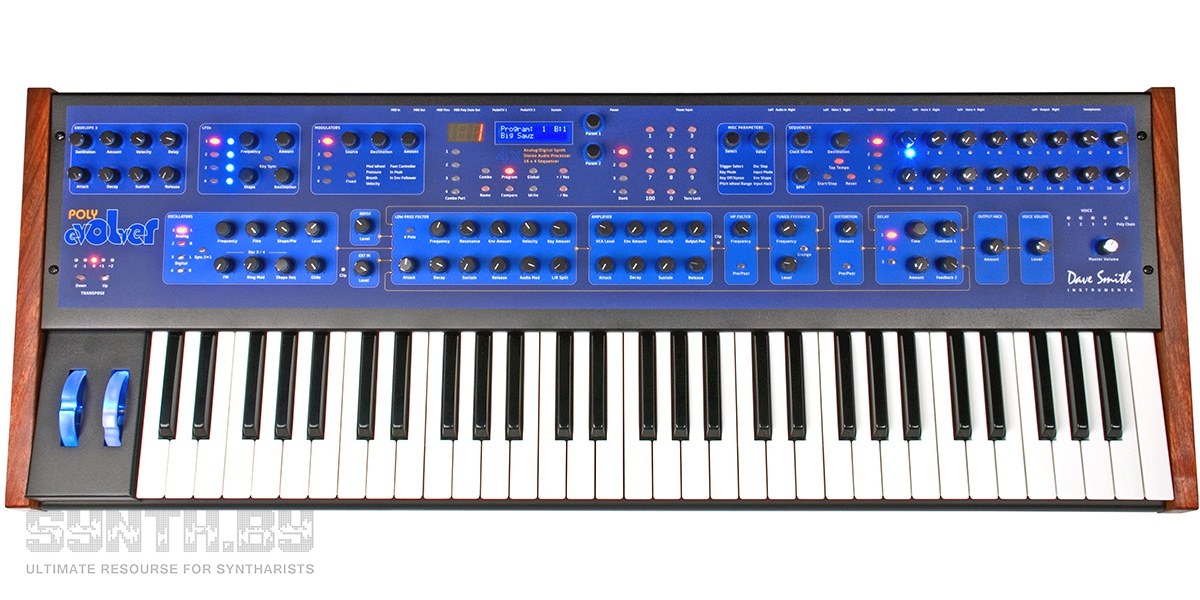The Dave Smith Poly Evolver Keyboard (PEK) represents the culmination of the Evolver evolution, transforming from its origins as a monophonic desktop unit into a fully-realized polyphonic keyboard synthesizer. Created by legendary synth designer Dave Smith — architect of the Prophet 5, the world's first truly programmable synthesizer, and co-creator of the MIDI protocol — the PEK marries cutting-edge digital technology with genuine analogue circuitry in an elegant, performance-ready package.
Design Philosophy & Build Quality
The Poly Evolver Keyboard is a stunning instrument that commands attention both sonically and visually. The front panel bristles with rotary encoders, illuminated switches, and distinctive blue LEDs that create a premium aesthetic. Wooden end cheeks add a touch of classic elegance, while the transparent pitch and modulation wheels glow with an ethereal blue light, making the instrument particularly striking in subdued lighting conditions. The lightweight velocity- and aftertouch-sensitive five-octave keyboard provides adequate response for the synth's complex sound palette.
The control panel represents a no-compromise approach to synthesizer design. Rather than hiding functions in menu systems, Dave Smith has provided dedicated knobs and switches for nearly every function, making this powerful instrument remarkably accessible despite its programming depth. The panel layout follows a logical left-to-right signal flow, with clear labeling that illustrates how audio moves through the instrument, including the various feedback paths that make the Evolver unique.
Synthesis Architecture
At its heart, the PEK combines the best attributes of both analogue and digital synthesis. Each of the four voices features a hybrid architecture consisting of:
- Two digitally controlled analogue oscillators (DCOs) offering sawtooth, triangle, saw/triangle mix, and pulse waves with pulse-width modulation and hard sync capabilities
- Two digital wavetable oscillators utilizing the classic Prophet VS waveforms with wave sequencing, FM, and ring modulation
- Analogue signal path including Curtis low-pass filters (switchable between 2-pole and 4-pole operation, self-resonating in 4-pole mode) and analogue voltage-controlled amplifiers
- Digital processing via A-D converters that route the signal to digital audio processors for effects and further manipulation
This hybrid approach delivers both the warmth and character of analogue synthesis and the precision, stability, and extensive modulation capabilities of digital technology. The architecture provides software-controlled LFOs and envelopes, four step sequencers per voice, comprehensive effects, sophisticated modulation routing, and 512 program memories.
Sound Character
The sonic palette of the PEK is vast and distinctive. The instrument excels at generating everything from warm, classic analogue textures to biting digital timbres. The digital oscillators intentionally retain their character, including aliasing at higher frequencies—a deliberate design choice that adds grit and personality rather than clinical perfection. This "trashy" quality at higher frequencies, reminiscent of the Prophet VS, contributes significantly to the instrument's unique voice.
The PEK's unique feedback section opens up sonic territories rarely accessible on other synthesizers. This feature, combined with the extensive modulation options and hybrid architecture, makes the instrument particularly adept at creating evolving, sci-fi textures and abstract atmospheric soundscapes that slowly develop over time. The presets explore everything from early electronic music aesthetics—channeling Tangerine Dream, Kraftwerk, and the BBC Radiophonic Workshop — to modern techno and beyond.
Equally capable of delivering powerful bass lines, lush pads, aggressive lead sounds, and intricate arpeggiated textures, the PEK proves versatile across virtually any musical genre. The instrument rewards experimentation, with an element of serendipity where a simple control adjustment can yield unexpected and inspiring results.
Operating Modes
The PEK offers three primary operating modes:
Program Mode provides straightforward four-voice polyphonic operation with access to 512 fully editable programs across four banks. A Unison mode allows all four voices to be stacked for massive, powerful sounds. Various playback triggering modes accommodate different performance styles.
Combo Mode delivers four-part multitimbrality by combining multiple programs. This mode proves particularly entertaining, with factory presets showcasing complete musical compositions utilizing all four step sequencers playing different parts. Combo mode enables keyboard splits, program stacking, and intricate polyrhythmic sequences running at different clock divisions and lengths. While each part remains strictly monophonic due to the four-voice architecture, the results can be remarkably complex and musically inspiring.
Global Mode handles utility functions including overall tuning, MIDI settings, sequencer clock configuration, external audio input gain, LCD contrast, and other system-wide parameters.
Control Interface
The control panel features continuous encoders for all parameters, allowing immediate parameter takeover from stored values. While this design enables fine-tuning accuracy and eliminates parameter jumps, some controls require multiple rotations to traverse their full range — the filter cutoff, for example, needs several turns for a complete sweep. The encoders lack physical end-stops, requiring occasional reference to the 2x16 character LCD display to confirm parameter values. Despite these minor considerations, the interface proves intuitive and rewarding, with zipper noise virtually eliminated.
The main synthesis controls occupy the prime real estate directly above the keyboard, arranged in logical signal-flow order. Envelope 3 and the four LFOs reside at the top left, while the four step sequencers sit at top right. The central programming area features plus/minus buttons, dual data encoders, and a large numeric keypad for accessing the 512 programs and 384 combos.
Connectivity
The rear panel offers extensive connectivity options. Beyond the headphone jack and main stereo outputs, each voice receives its own stereo output pair — eight jacks total. Inserting cables into these balanced quarter-inch jacks automatically removes those signals from the main mix, enabling sophisticated routing and processing options. A stereo audio input pair allows external signals to be processed through the PEK's filters and effects.
MIDI connectivity includes the standard In, Out, and Thru connections, plus a special MIDI/DIN connector for daisy-chaining additional Evolvers to expand polyphony. Performance-oriented inputs include sustain pedal and two assignable continuous pedal/CV inputs (responding to expression pedals or 0-5 VDC control voltages). Four bright blue LEDs on the rear panel pulsate in sync with the four LFO rates — pure eye candy with no practical function, but visually arresting nonetheless.
Considerations
The PEK utilizes an external power supply rather than an internal unit — a minor disappointment given the instrument's premium positioning. The absence of digital audio outputs may limit integration in modern digital studios. Most significantly, the four-voice polyphony, while adequate for many applications, can prove restrictive for dense chord work or layered arrangements. Voice stealing becomes apparent when attempting anything beyond simple triads with bass notes. The polyphony cannot be expanded via internal cards, though multiple Poly Evolvers can be daisy-chained for additional voices.
Philosophy & Longevity
Dave Smith's decision to return to hardware synthesis despite having developed the world's first software synthesizer (Seer Systems' Reality) stems from practical philosophy. He views hardware instruments as inherently more reliable and valuable long-term investments compared to software, which requires constant updates across evolving operating systems and host environments. The PEK's robust construction and timeless design approach suggest it will remain musically relevant and inspiring for decades to come.
Conclusion
The Dave Smith Poly Evolver Keyboard stands as a powerful, unique-sounding synthesizer with vast sonic potential. Its hands-on control interface makes the complex synthesis engine manageable and even intuitive, while retaining enough depth to reward years of exploration. The instrument looks fantastic, sounds distinctive, and offers capabilities that set it apart from competitors. While the four-voice polyphony and external power supply represent compromises, they don't diminish the PEK's status as a premium, no-compromise instrument in the truest sense. It excels equally in studio and stage environments, delivering a hybrid synthesis experience that could be explored for years without exhausting its creative possibilities.
Technical Specifications
Keyboard & Performance Controls
- Keyboard: 5-octave (61-key), semi-weighted action
- Velocity Sensitivity: Yes
- Aftertouch: Yes (channel aftertouch)
- Pitch Wheel: Spring-loaded, transparent with blue LED illumination
- Modulation Wheel: Assignable, transparent with blue LED illumination
- Visual Features: Blue LED illumination throughout, pulsating LFO indicators
Polyphony & Sound Architecture
- Voices: 4-voice polyphony
- Voice Expansion: Via daisy-chaining additional Poly Evolvers (Poly Chain connector)
- Operating Modes: Program, Combo, Global
- Multitimbrality: 4-part (in Combo mode, each part monophonic)
- Unison Mode: Stack all 4 voices for massive sounds
- Memory: 512 fully editable Programs (4 banks of 128)
- Combos: 384 Combos (3 banks of 128)
- Program Access: Numeric keypad for direct access, plus/minus buttons, dual data encoders
- External Processing: Route external audio through filters and effects
Oscillators (Per Voice)
- Analogue Oscillators: 2 digitally controlled analogue oscillators (DCOs)
- Waveforms: Sawtooth, Triangle, Saw/Triangle mix, Pulse (with pulse-width modulation)
- Features: Hard sync capability
- Digital Oscillators: 2 digital wavetable oscillators
- Waveforms: Prophet VS waves
- Features: Wave sequencing capability, FM (frequency modulation), Ring modulation
- Noise Generator: White noise generator
Filters (Per Voice)
- Analogue Filters: 2 low-pass filters (1 per channel)
- Type: Curtis filters
- Modes: Selectable 2-pole and 4-pole operation
- Resonance: Self-resonating in 4-pole mode
- Digital Filter: High-pass filter
Amplifiers
- VCA Type: Analogue voltage-controlled amplifiers (VCAs)
Modulation
- Envelope Generators: 3 per voice (four-stage ADSR)
- Filter envelope
- VCA envelope
- Assignable envelope (Envelope 3)
- LFOs: 4 per voice
- Step Sequencers: 4 per voice (16 x 4 steps each)
- Glide/Portamento: Separate rates per oscillator
Effects & Processing
- Digital Delays: 3 separate, syncable, stereo delay lines per voice
- Distortion: Dedicated distortion with amount control
- Output Hack: Additional tone-shaping feature
- Feedback: Tuned feedback with "Grunge" control — use feedback as pitched sound source
- Signal Path: Analogue-to-digital and digital-to-analogue conversion for hybrid processing
Inputs & Outputs
Audio
- Main Outputs: Stereo, 1/4" unbalanced
- Individual Voice Outputs: 4 stereo pairs (8 jacks total), 1/4" balanced
- Note: Inserting cables removes signal from main outputs
- Audio Inputs: Stereo, 1/4" unbalanced (for external audio processing)
- Headphone Output: 1/4" stereo phone jack
MIDI
- MIDI In: Standard 5-pin DIN
- MIDI Out: Standard 5-pin DIN
- MIDI Thru: Standard 5-pin DIN
- Poly Chain: Special MIDI/DIN connector for daisy-chaining Evolvers
Control
- Sustain Pedal Input: Accepts normally-on or normally-off momentary footswitch
- Pedal/CV1 Input: Expression pedal or 0-5 VDC control voltage (protected against higher or negative voltages)
- Pedal/CV2 Input: Expression pedal or 0-5 VDC control voltage (protected against higher or negative voltages)
Display & Interface
- Display: 2-line x 16-character LCD with contrast control
- Controls: Rotary encoders (continuous type), illuminated switches
- LED Indicators: Blue LEDs for various functions including:
- Master octave indicators
- LFO rate indicators (front panel, 4 total)
- LFO rate indicators (rear panel, 4 additional)
- Pitch/mod wheel illumination
Physical Specifications
- Dimensions:
- Width: 14.00" (35.56 cm)
- Length: 38.5" (97.79 cm)
- Height: 5.09" (12.95 cm) at rear, 2.84" at front edge. Note: Feet account for 0.625" of total height
- Weight: Approximately 28 lbs (12.7 kg)
- Finish: Wooden end cheeks, professional cosmetic design
Power
- Power Supply: External PSU
- Output: 15 VDC, 1300 mA
Tags: analog synthesizer











